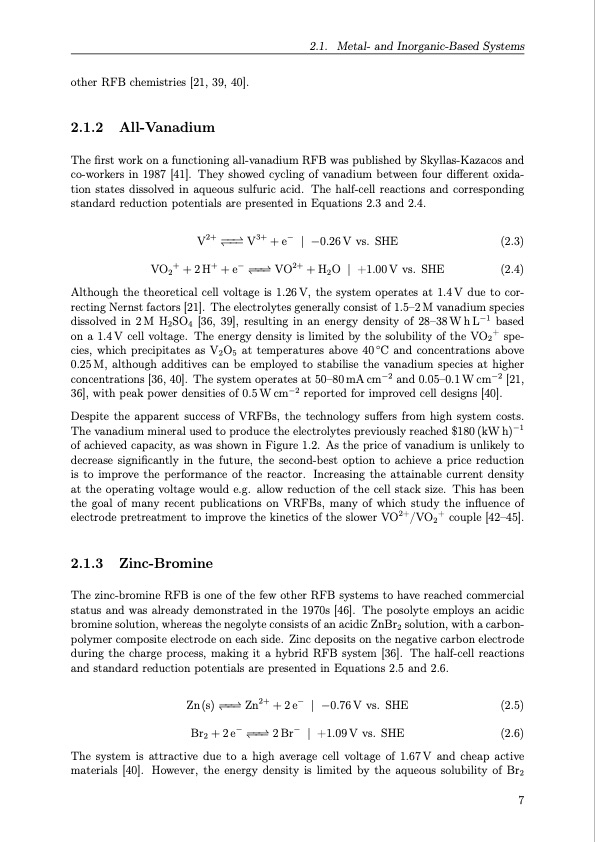
PDF Publication Title:
Text from PDF Page: 028
other RFB chemistries [21, 39, 40]. 2.1.2 All-Vanadium The first work on a functioning all-vanadium RFB was published by Skyllas-Kazacos and co-workers in 1987 [41]. They showed cycling of vanadium between four different oxida- tion states dissolved in aqueous sulfuric acid. The half-cell reactions and corresponding standard reduction potentials are presented in Equations 2.3 and 2.4. V2+ −↽−⇀− V3+ + e− | −0.26 V vs. SHE (2.3) VO2+ + 2 H+ + e− −↽−⇀− VO2+ + H2O | +1.00 V vs. SHE (2.4) Although the theoretical cell voltage is 1.26V, the system operates at 1.4V due to cor- recting Nernst factors [21]. The electrolytes generally consist of 1.5–2 M vanadium species dissolved in 2 M H2SO4 [36, 39], resulting in an energy density of 28–38 W h L−1 based on a 1.4V cell voltage. The energy density is limited by the solubility of the VO2+ spe- cies, which precipitates as V2O5 at temperatures above 40◦C and concentrations above 0.25M, although additives can be employed to stabilise the vanadium species at higher concentrations [36, 40]. The system operates at 50–80 mA cm−2 and 0.05–0.1 W cm−2 [21, 36], with peak power densities of 0.5 W cm−2 reported for improved cell designs [40]. Despite the apparent success of VRFBs, the technology suffers from high system costs. The vanadium mineral used to produce the electrolytes previously reached $180 (kW h)−1 of achieved capacity, as was shown in Figure 1.2. As the price of vanadium is unlikely to decrease significantly in the future, the second-best option to achieve a price reduction is to improve the performance of the reactor. Increasing the attainable current density at the operating voltage would e.g. allow reduction of the cell stack size. This has been the goal of many recent publications on VRFBs, many of which study the influence of electrode pretreatment to improve the kinetics of the slower VO2+/VO2+ couple [42–45]. 2.1.3 Zinc-Bromine The zinc-bromine RFB is one of the few other RFB systems to have reached commercial status and was already demonstrated in the 1970s [46]. The posolyte employs an acidic bromine solution, whereas the negolyte consists of an acidic ZnBr2 solution, with a carbon- polymer composite electrode on each side. Zinc deposits on the negative carbon electrode during the charge process, making it a hybrid RFB system [36]. The half-cell reactions and standard reduction potentials are presented in Equations 2.5 and 2.6. Zn(s)−↽−⇀−Zn2++2e− | −0.76Vvs.SHE (2.5) Br2+2e−−↽−⇀−2Br− |+1.09Vvs.SHE (2.6) The system is attractive due to a high average cell voltage of 1.67V and cheap active materials [40]. However, the energy density is limited by the aqueous solubility of Br2 2.1. Metal- and Inorganic-Based Systems 7PDF Image | Organic Redox Flow Batteries 2023

PDF Search Title:
Organic Redox Flow Batteries 2023Original File Name Searched:
PhD_thesis_final_dorhoff_4_.pdfDIY PDF Search: Google It | Yahoo | Bing
Salgenx Redox Flow Battery Technology: Salt water flow battery technology with low cost and great energy density that can be used for power storage and thermal storage. Let us de-risk your production using our license. Our aqueous flow battery is less cost than Tesla Megapack and available faster. Redox flow battery. No membrane needed like with Vanadium, or Bromine. Salgenx flow battery
| CONTACT TEL: 608-238-6001 Email: greg@salgenx.com | RSS | AMP |